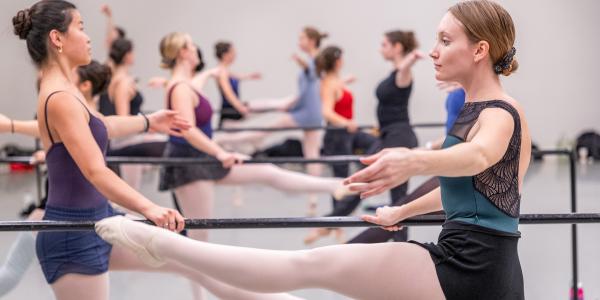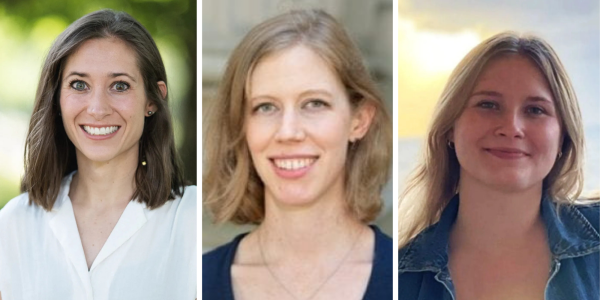Douthit-Boyd has stepped into the role of ballet master to help build a new future for classical ballet with WashU’s dance students.
After moving to New York City in the early 2000s to work as a principal dancer with the legendary Alvin Ailey American Dance Theater and as a soloist at the Dance Theater of Harlem, Antonio Douthit-Boyd never thought he’d land back in his hometown of St. Louis.
But upon returning to the Midwest nine years ago, he found himself working part-time as a professor of practice in dance in WashU’s Performing Arts Department and serving as artistic co-director of dance at the nearby Center of Creative Arts (COCA).
This fall, he joined WashU full-time to become PAD’s official ballet master. He sat down with the Ampersand to talk about his journey, his dance philosophy, and the future of classical dance at WashU.

Tell us about your journey from St. Louis to the heart of the New York City dance world and back.
I came to dance at the age of 16, which people say is quite late. I was walking with a group of friends down a street near Compton and Washington Avenues in St. Louis when we heard drums coming from a building. We went inside and found Angela Culbertson, artistic director of aTrek Dance Collective, holding a class. We messed around in the back of the room and, after first telling us to leave, she let us stay and invited us back for another class. At first, we all laughed, but I thought about it afterward and realized how exuberant my body felt being in that room and moving in that way.
The next time I walked by the studio with my friends, they kept going and I went inside. It all happened from there. Angela saw promise in me and called Dance St. Louis, which sent me to the Center of Creative Arts (COCA). I grew up in north St. Louis in a very low-income neighborhood where opportunities were hard to find. But people took a liking to me and said I had talent, mentoring me along the way.
I got a college scholarship for dance but after one year I left for New York City and became a soloist with Dance Theater Harlem. After that, I became a principal dancer at Alvin Ailey American Dance Theater, where I toured for almost 13 years. That’s where I met my husband, Kirven Douthit-Boyd, who was also an Ailey dancer and is now the artistic director at Big Muddy Dance Company.
When I introduced Kirven to St. Louis, he fell in love with the town. He was so impressed with the community support and engagement with the arts. For 10 years, we came back every summer for two weeks to teach dance intensives at COCA. We saw such progress in the kids, even over two weeks. When it came time for us to step back from performing, becoming artistic co-directors of dance at COCA was a natural step. Then, after a year, we were both hired by WashU to be professors in the Performing Arts Department.
What’s your philosophy as a dance teacher?
It can be a challenge when you have different levels of students in the same class, but I try to teach to the level of the most advanced student while meeting each person where they are. But it shouldn’t be heavy. In a sense, dance is play.
At this time in our society and in our world, students need an outlet. For my dancers, I want them to feel as though dance is something that can push past the hardships in life. It did that for me; I want to make it that way for everyone else.
Recently, things were tense on campus. In the days after the attacks in Israel, there were vigils to commemorate what was going on in the Middle East. When students came to my class, they were very heavy, and so I changed my combinations right away. When things like this happen, I like to try to adjust the music and push my students in a different direction. The arts can be a healing balm.

How has WashU’s program changed since you’ve been here?
In the eight years since WashU added a Master of Fine Arts in Dance, we’ve come a long way in putting WashU’s program on the map. If you have a love of the arts and are also strong academically, WashU is the place to be. I think WashU is now running with some of the top dogs in the performing arts.
When I first came, there were some dance majors, but the number has grown. When Kirven and I joined the department along with Cecil (Slaughter), David (Marchant), and Joanna (Dee Das), we agreed that all of our dancers — regardless of their major or skill level — should receive high-quality training. This ensures that they have the necessary skills and knowledge to make informed decisions about pursuing dance after their time at WashU while still nurturing their passion for the art form. We’ve seen a big turnaround, with students finishing the program and going off to New York and elsewhere to become dancers. The program is pushing them to do it not just as a hobby, though, of course, we also welcome dancers who are here for fun.
What do you see as the future of classical ballet?
In the past, ballet has been pigeonholed with a museum vibe, as though it is something that only a certain kind of person can do. I love ballet and it’s brought me to where I am today. But there have been issues with the art form. It has not always been accessible to certain body types and it’s a very expensive sport. We are breaking down some of those barriers and stereotypes at WashU.
I think the future of classical ballet, in general — and especially at WashU — is extremely bright. Having an African-American male at the helm of WashU’s ballet program helps, as does having dancers willing to voice their opinions about traditional views around ballet and what a new ballet aesthetic could and should be. Breaking down these traditions in an academic setting helps move the art form in a whole new direction — I think for the better.
What’s next for you and WashU dance?
Part of breaking down barriers to access means taking ballet out of the museum and into the community. WashU is poised to do that through outreach programs like Spring to Dance, which brings dance to more people. Next semester I’m teaching a pedagogy class, helping dance students learn how to be better dance teachers and young artists so they can inspire other dancers and artists in the community.
I’m a teacher first, but I’ve been encouraged to do some choreography alongside David Marchant and new faculty member Elinor Harrison. This work will debut at the WashU dance performance WUDT’sNEXT in the first week of December. I was hesitant to try choreography, but my husband Kirven encouraged me to give it a try and it’s been such a beautiful experience. Everyone on campus should come to see these young people perform. They are so stunning and they have persevered through so many challenges and obstacles in their academic careers. It’s going to be fantastic.





